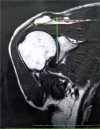Correlation of acromial morphology in association with rotator cuff tear: a retrospective study
- PMID: 31969966
- PMCID: PMC6964320
- DOI: 10.5114/pjr.2019.90277
Correlation of acromial morphology in association with rotator cuff tear: a retrospective study
Abstract
Purpose: There have been many studies that have attempted to correlate radiographic acromial characteristics with rotator cuff tears, but the results have not been conclusive. Rotator cuff tears (RCT) are the common aetiology of shoulder pain. We assessed the association of rotator cuff tears with commonly used radiographic parameters of acromial morphology and their different radiographic characteristics.
Material and methods: From a retrospective study of 98 patients, we characterised acromial type and measured acromial thickness (AT), critical shoulder angle (CSA), lateral acromial angle (LAA), acromiohumeral distance (AHD), and acromion index (AI) on a 1.5T MRI, from 68 patients with partial or full-thickness supraspinatus tendon tears and 30 controls without tears.
Results: Out the 68 patients with rotator cuff tear, supraspinatus was the most commonly affected tendon, with 86% (59) cases showing abnormalities. The average age of the patients was 45.11 ± 21.45 years with male dominance (80%). Partial tears of rotator cuff were more common than complete tears. Forty-eight cases showed partial tears in supraspinatus as compared to 11 cases of complete tears. The acromial type did not show any correlation with any particular cuff lesion. The AT and AI of controls were significantly smaller than cuff-tear patients. The LAA of cuff-tear patients was significantly different from that of control patients. The impingement patients demonstrated a significantly greater acromial thickness, larger CSA, decreased AHD, and decreased LAA than their control counterparts.
Conclusions: A higher prevalence of rotator cuff tears and impingement associated with low lateral acromial angle, larger CSA and decreased AHD was observed. AT and AI have a direct correlation with rotator cuff tear.
Keywords: acromion; rotator cuff; supraspinatus.
Copyright © Polish Medical Society of Radiology 2019.
Conflict of interest statement
The authors report no conflict of interest.
Figures
Similar articles
-
Correlation of acromial morphology with impingement syndrome and rotator cuff tears.Acta Orthop. 2013 Apr;84(2):178-83. doi: 10.3109/17453674.2013.773413. Epub 2013 Feb 15. Acta Orthop. 2013. PMID: 23409811 Free PMC article.
-
The Correlation between Various Shoulder Anatomical Indices on X-Ray and Subacromial Impingement and Morphology of Rotator Cuff Tears.Orthop Surg. 2023 Aug;15(8):1997-2006. doi: 10.1111/os.13610. Epub 2022 Dec 26. Orthop Surg. 2023. PMID: 36573272 Free PMC article.
-
A comprehensive analysis of the acromial morphology and etiological factors of partial rotator cuff tears.JSES Int. 2024 Aug 30;9(1):86-90. doi: 10.1016/j.jseint.2024.08.194. eCollection 2025 Jan. JSES Int. 2024. PMID: 39898223 Free PMC article.
-
Anatomic shoulder parameters and their relationship to the presence of degenerative rotator cuff tears and glenohumeral osteoarthritis: a systematic review and meta-analysis.J Shoulder Elbow Surg. 2019 Dec;28(12):2457-2466. doi: 10.1016/j.jse.2019.05.008. Epub 2019 Jul 26. J Shoulder Elbow Surg. 2019. PMID: 31353303
-
The keeled acromion: an aggressive acromial variant--a series of 20 patients with associated rotator cuff tears.Arthroscopy. 2004 Sep;20(7):744-53. doi: 10.1016/j.arthro.2004.06.018. Arthroscopy. 2004. PMID: 15346116 Review.
Cited by
-
[Evaluation methods of postoperative healing of supraspinatus tendon tear].Zhongguo Xiu Fu Chong Jian Wai Ke Za Zhi. 2022 Sep 15;36(9):1172-1177. doi: 10.7507/1002-1892.202206054. Zhongguo Xiu Fu Chong Jian Wai Ke Za Zhi. 2022. PMID: 36111482 Free PMC article. Chinese.
-
Literature Review of Anatomical Variations: Clinical Significance, Identification Approach, and Teaching Strategies.Cureus. 2021 Apr 13;13(4):e14451. doi: 10.7759/cureus.14451. Cureus. 2021. PMID: 33996311 Free PMC article. Review.
-
Relevance between Proximal Humeral Migration and Rotator Cuff Tears.Front Surg. 2022 May 5;9:903538. doi: 10.3389/fsurg.2022.903538. eCollection 2022. Front Surg. 2022. PMID: 35599789 Free PMC article.
-
Anatomic characteristics of shoulder based on MRI accurately predict incomplete rotator cuff injuries in patients: relevance for predictive, preventive, and personalized healthcare strategies.EPMA J. 2023 Jul 13;14(3):553-570. doi: 10.1007/s13167-023-00333-5. eCollection 2023 Sep. EPMA J. 2023. PMID: 37605646 Free PMC article.
-
Correlation of Multiple Acromion Morphological Parameters on Radiographs in a Geriatric Chinese Population and Its Clinical Significance.Geriatr Orthop Surg Rehabil. 2021 Oct 11;12:21514593211043990. doi: 10.1177/21514593211043990. eCollection 2021. Geriatr Orthop Surg Rehabil. 2021. PMID: 34659869 Free PMC article.
References
-
- Mansur DI, Khanal K, Haque MK, et al. Morphometry of acromion process of human scapulae and its clinical importance amongst nepalese population. Kathmandu Univ Med J (KUMJ) 2013;10:33–36. - PubMed
-
- Neer CS., 2nd Impingement lesions. Clin Orthop Relat Res. 1983;173:70–77. - PubMed
-
- Vitale MA, Arons RR, Hurwitz S, et al. The rising incidence of acromioplasty. J Bone Joint Surg Am. 2010;92:1842–1850. - PubMed
-
- Bigliani LU, Ticker JB, Flatow EL, et al. The relationship of acromial architecture to rotator cuff disease. Clin Sports Med. 1991;10:823–838. - PubMed
LinkOut - more resources
Full Text Sources



